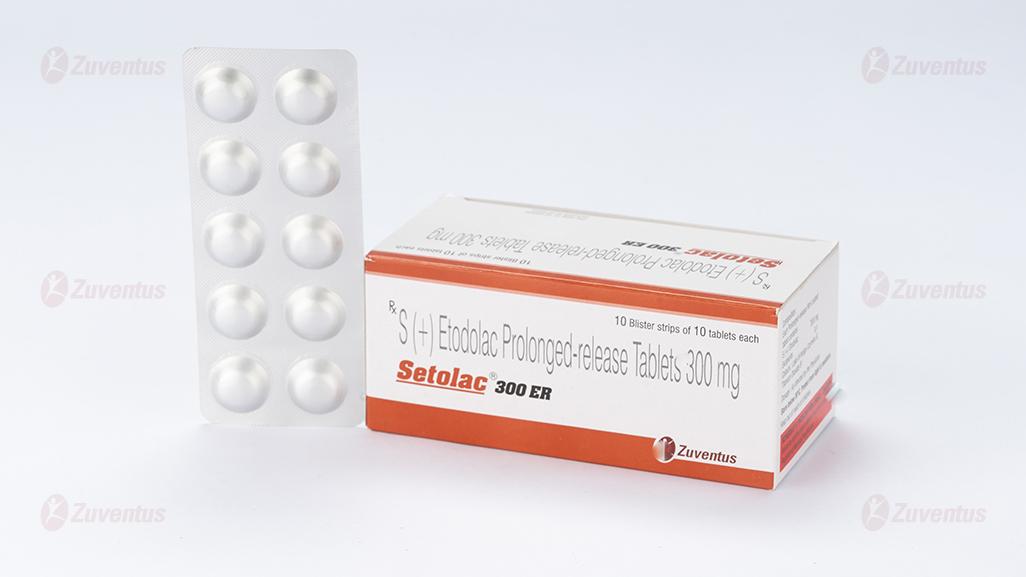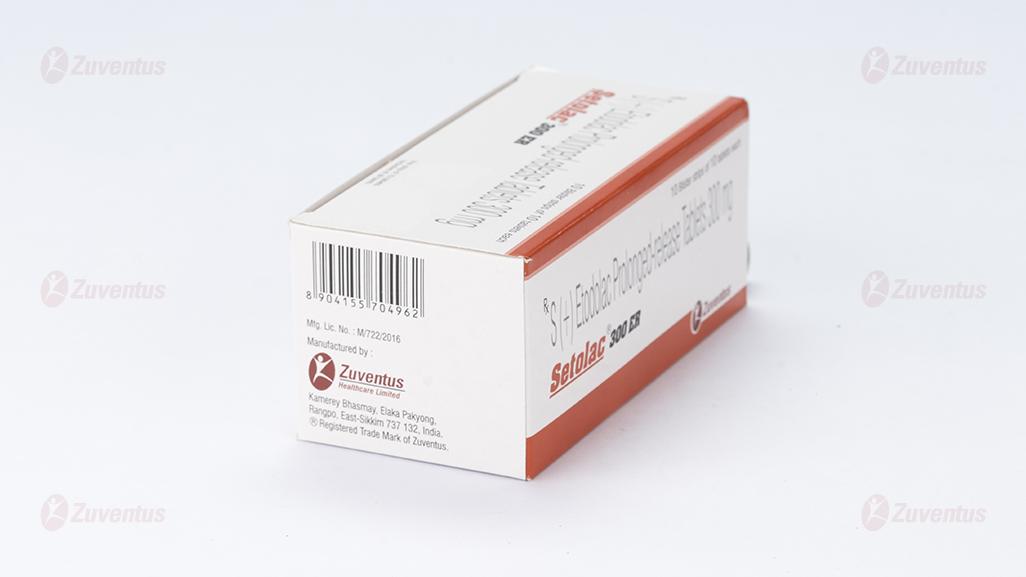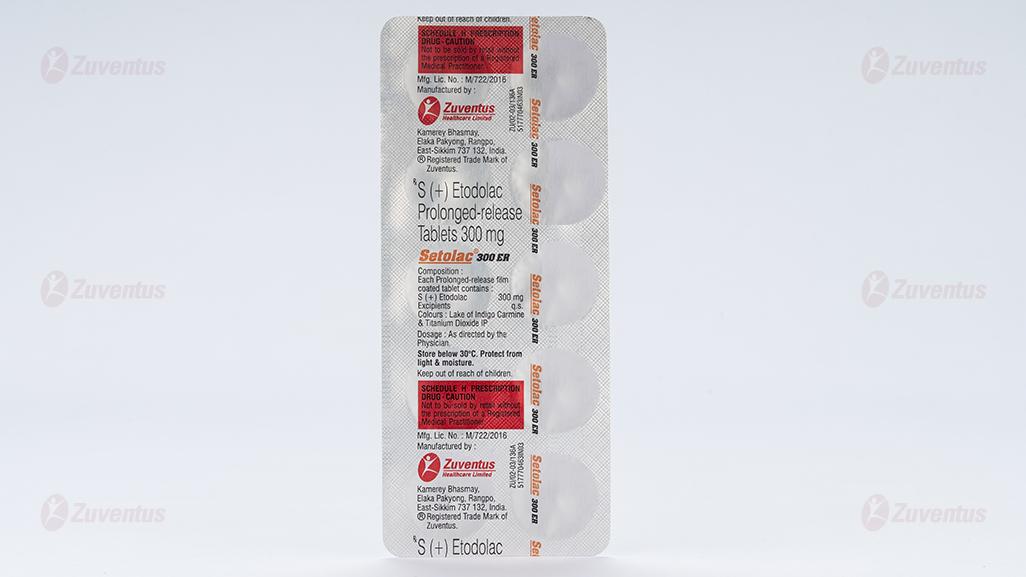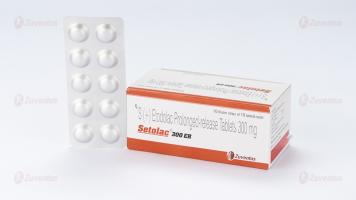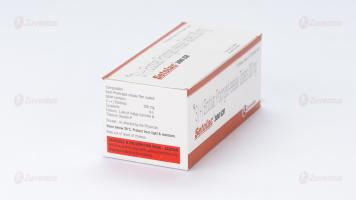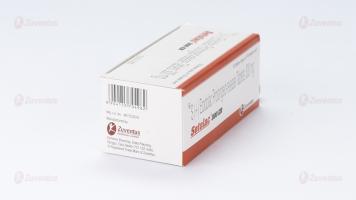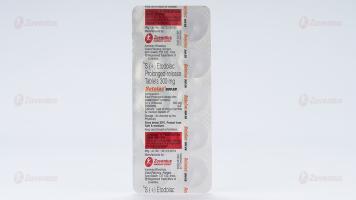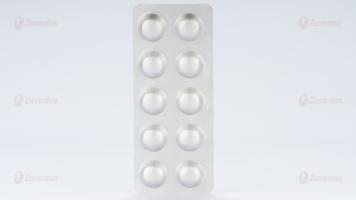Setolac 300 ER Tablets
Therapy Area
Pain management
1.0 Name of the medicinal product
S-(+)-Etodolac Prolonged-Release Tablets 300 mg
2.0 Qualitative and quantitative composition
Each Prolonged-Release film coated tablet contains:
S-(+)-Etodolac 300 mg
Excipients q.s
3.0 Dosage form and strength
Tablet, 300 mg
4.0 Clinical Particulars
4.1 Therapeutic indication
For the relief of pain and inflammation in patients with rheumatoid arthritis and osteoarthritis.
4.2 Posology and method of administration
Undesirable effects may be minimised by using the lowest effective dose for the shortest duration necessary to control symptoms.
Adults: One tablet daily.
The safety of doses in excess of 300mg per day has not been established. No occurrence of tolerance or tachyphylaxis has been reported.
Elderly: No change in initial dosage is generally required in the elderly.
The elderly population are at increased risk of the serious consequences of adverse reactions. If an NSAID is considered necessary, the lowest effective dose should be used and for the shortest possible duration. The patient should be monitored regularly for GI bleeding during NSAID therapy.
Paediatric population: Not recommended.
Method of administration: For oral administration.
To be taken preferably with or after food. Swallow the tablet whole with a glass of water.
4.3 Contraindications
- Hypersensitivity to the active substance or to any of the excipients.
- Setolac 300 ER Tablets should not be used in patients with severe heart failure.
- Setolac 300 ER Tablets should not be used in patients with active or history of recurrent peptic ulceration or a history of peptic ulcer disease (with two or more distinct episodes of proven ulceration or bleeding).
- NSAIDs are contraindicated in patients who have previously shown hypersensitivity reactions (e.g. asthma, rhinitis angioedema or urticaria) during therapy with ibuprofen, aspirin or other non-steroidal anti-inflammatory drugs.
- Severe heart failure, hepatic failure and renal failure
- During the last trimester of pregnancy
- History of gastrointestinal bleeding or perforation, related to previous NSAIDs therapy.
4.4 Special warnings and precautions for use
Undesirable effects may be minimised by using the lowest effective dose for the shortest duration necessary to control symptoms.
The use of Setolac 300 ER Tablets with concomitant NSAIDs including cyclooxygenase-2-selective inhibitors should be avoided.
Elderly:
The elderly people have an increased frequency of adverse reactions to NSAIDs especially gastrointestinal bleeding and perforation which may be fatal.
Cardiovascular and cerebrovascular effects:
Appropriate monitoring and advice are required for patients with a history of hypertension and/or mild to moderate congestive heart failure as fluid retention and oedema have been reported in association with NSAID therapy.
Clinical trial and epidemiological data suggest that use of some NSAIDs (particularly at high doses and in long term treatment) may be associated with a small increased risk of arterial thrombotic events (for example myocardial infarction or stroke). There are insufficient data to exclude such a risk for Setolac 300 ER Tablets.
Patients with uncontrolled hypertension, congestive heart failure, established ischaemic heart disease, peripheral arterial disease, and/or cerebrovascular disease should only be treated with Setolac 300 ER Tablets after careful consideration. Similar consideration should be made before initiating longer-term treatment of patients with risk factors for cardiovascular disease (e.g. hypertension, hyperlipidaemia, diabetes mellitus, smoking).
Respiratory disorders:
Caution is required if Setolac 300 ER Tablets is administered to patients suffering from, or with a previous history of, bronchial asthma since NSAIDs have been reported to precipitate bronchospasm in such patients.
Cardiovascular, Renal and Hepatic Impairment:
In patients with renal, cardiac or hepatic impairment especially those taking diuretics and the elderly, renal function should be monitored in these patients. Caution is required since the use of NSAIDs may result in a dose dependent reduction in prostaglandin formation and precipitate renal failure. The dose should be kept as low as possible. However, impairment of renal or hepatic functions due to other causes may alter drug metabolism; patients receiving concomitant long term therapy, especially the elderly, should be observed for potential side effects and their drug doses adjusted as needed, or the drug discontinued.
Gastrointestinal bleeding, ulceration and perforation:
Serious gastrointestinal adverse effects such as bleeding, ulceration and perforation, which can be fatal, has been reported and can occur at any time with or without warning symptoms in patients treated with NSAIDs or a previous history of serious GI events. If any sign of gastrointestinal bleeding occurs, Setolac 300 ER Tablets should be stopped immediately.
Platelets:
Although non-steroidal anti-inflammatory drugs do not have the same direct effects on platelets as does aspirin, all drugs which inhibit the biosynthesis of prostaglandins may interfere, to some extent, with platelet function. Patients receiving Setolac 300 ER Tablets who may be adversely affected by such actions should be carefully observed.
Patients on long-term treatment with Setolac 300 ER Tablets should be regularly reviewed as a precautionary measure e.g. for changes in, renal function, haematological parameters, or hepatic function.
The risk of GI bleeding, ulceration or perforation is higher with increasing NSAID doses, in patients with a history of ulcer, particularly if complicated with haemorrhage or perforation, and in the elderly. These patients should commence treatment on the lowest dose available. Combination therapy with protective agents (e.g. misoprostol or proton pump inhibitors) should be considered for these patients, and also for patients requiring concomitant low dose aspirin, or other drugs likely to increase gastrointestinal risk.
Patients with a history of GI toxicity, particularly when elderly, should report any unusual abdominal symptoms (especially GI bleeding) particularly in the initial stages of treatment.
Caution should be advised in patients receiving concomitant medications which could increase the risk of ulceration or bleeding, such as oral corticosteroids, anticoagulants such as warfarin, selective serotonin-reuptake inhibitors or anti-platelet agents such as aspirin.
When GI bleeding or ulceration occurs in patients receiving Etodolac, the treatment should be withdrawn.
NSAIDs should be given with care to patients with a history of gastrointestinal disease (ulcerative colitis, Crohn's disease) as these conditions may be exacerbated.
SLE and mixed connective tissue disease:
In patients with systemic lupus erythematous (SLE) and mixed connective tissue disorders there may be an increased risk of aseptic meningitis.
Dermatological:
Serious skin reactions, some of them fatal, including exfoliative dermatitis, Stevens-Johnson syndrome, and toxic epidermal necrolysis, have been reported very rarely in association with the use of NSAIDs (see section 4.8). Patients appear to be at highest risk for these reactions early in the course of therapy: the onset of the reaction occurring in the majority of cases within the first month of treatment. Setolac 300 ER Tablets should be discontinued at the first appearance of the skin rash, mucosal lesions, or any other sign of hypersensitivity.
4.5 Drug interactions
Since Setolac 300 ER Tablets is extensively protein-bound, it may be necessary to modify the dosage of other highly protein-bound drugs.
Other analgesics including cyclooxygenase-2 selective inhibitor: Avoid concomitant use of two or more NSAIDs (including aspirin) as this may increase the risk of adverse effects (see section 4.4)
Anti-hypertensives: Reduced anti-hypertensive effect
Diuretics: Reduced diuretic effect. Diuretics can increase the risk of nephrotoxicity of NSAIDs.
Cardiac glycosides: NSAIDs may exacerbate cardiac failure, reduce GFR and increase plasma glycoside levels.
Lithium: Decreased elimination of lithium
Methotrexate: Decreased elimination of methotrexate
Ciclosporin: Increased risk of nephrotoxicity
Anti-coagulants: NSAIDs may enhance the effects of anti-coagulants, such as warfarin (see section 4.4)
Anti-platelet agents: and selective serotonin reuptake inhibitors (SSRIs): Increased risk of gastrointestinal bleeding (see section 4.4)
Tacrolimus: Possible increased risk of nephrotoxicity when NSAIDs are given with tacrolimus.
Zidovudine: Increased risk of haematological toxicity when NSAIDs are given with zidovudine. There is a evidence of an increased risk of haemarthroses and haemtoma in HIV(+) haemophiliacs receiving concurrent treatment with zidovudine and ibuprofen.
Bilirubin tests can give a false positive result due to the presence of phenolic metabolites of Setolac 300 ER Tablets in the urine.
Mifepristone: NSAIDs should not be used for 8-12 days after mifepristone administration as NSAIDs can reduce the effect of mifepristone.
Corticosteroids: increased risk of gastrointestinal ulceration or bleeding (see section 4.4)
Quinolone antibiotics: animal data indicate that NSAIDs can increase the risk of convulsions associated with quinolone antibiotics. Patients taking NSAIDs and quinolones may have an increased risk of developing convulsions.
4.6 Use in special populations (such as pregnant women, lactating women, paediatric patients, geriatric patients etc.)
Fertility:
The use of Setolac 300 ER Tablets may impair female fertility and is not recommended in woman attempting to conceive. In women who have difficulties conceiving or who are undergoing investigation of infertility, withdrawal of Setolac 300 ER Tablets should be considered.
Pregnancy:
Drugs which inhibit prostaglandin biosynthesis may cause dystocia and delayed parturition as evidenced by studies in pregnant animals.
Congenital abnormalities have been reported in association with NSAID administration in man; however, these are low in frequency and do not appear to follow any discernible pattern. In view of the known effects of NSAIDs on the foetal cardiovascular system, some inhibitors of prostaglandin biosynthesis have been shown to interfere with the risk of closure of the ductus arteriosus, use in the last trimester of pregnancy is contraindicated. The onset of labour may be delayed and the duration increased with an increased bleeding tendency in both mother and child.
From the 20th week of pregnancy onward, etodolac use may cause oligohydramnios resulting from foetal renal dysfunction. This may occur shortly after treatment initiation and is usually reversible upon discontinuation. In addition, there have been reports of ductus arteriosus constriction following treatment in the second trimester, most of which resolved after treatment cessation. Therefore, during the first and second trimester of pregnancy, etodolac should not be given unless clearly necessary. If etodolac is used by a woman attempting to conceive, or during the first and second trimester of pregnancy, the dose should be kept as low and duration of treatment as short as possible. Antenatal monitoring for oligohydramnios and ductus arteriosus constriction should be considered after exposure to etodolac for several days from gestational week 20 onward. Etodolac should be discontinued if oligohydramnios or ductus arteriosus constriction are found.
During the third trimester of pregnancy, all prostaglandin synthesis inhibitors may expose the foetus to:
- cardiopulmonary toxicity (premature constriction/closure of the ductus arteriosus and pulmonary hypertension);
- renal dysfunction (see above);
the mother and the neonate, at the end of pregnancy, to:
- possible prolongation of bleeding time, an anti-aggregating effect which may occur even at very low doses.
- inhibition of uterine contractions resulting in delayed or prolonged labour.
Consequently, etodolac is contraindicated during the third trimester of pregnancy.
Lactation:
In limited studies so far available, NSAIDs can appear in breast milk in very low concentrations. NSAIDs should, if possible, be avoided when breastfeeding.
4.7 Effects on ability to drive and use machines
Setolac 300 ER can cause dizziness, drowsiness, fatigue or abnormal vision. Patients need to be aware of how they react to this medicine before driving or operating machines.
4.8 Undesirable effects
Oedema, hypertension and cardiac failure, have been reported in association with NSAID treatment. Clinical trial and epidemiological data suggest that use of some NSAIDs (particularly at high doses and in long term treatment) may be associated with an increased risk of arterial thrombotic events (for example myocardial infarction or stroke).
Gastrointestinal: Reported side effects include nausea, epigastric pain, diarrhoea, indigestion, heartburn, flatulence, abdominal pain, constipation, vomiting, ulcerative stomatitis, dyspepsia, haematemesis, melaena, rectal bleeding, exacerbation of colitis, vasculitis, headaches, dizziness, abnormal vision, pyrexia, drowsiness, tinnitus, rash, pruritus, fatigue, depression, insomnia, confusion, paraesthesia, tremor, weakness/malaise, dyspnoea, palpitations, bilirubinuria, hepatic function abnormalities and jaundice, urinary frequency, dysuria, angioedema, anaphylactoid reaction, photosensitivity, urticaria and Stevens-Johnson syndrome and Crohn's disease have been reported following administration. Less frequently, gastritis has been observed. Pancreatitis has been reported very rarely.
Hypersensitivity: Hypersensitivity reactions have been reported following treatment with NSAIDs. These may consist of (a) non-specific allergic reactions and anaphylaxis (b) respiratory tract reactivity comprising asthma, aggravated asthma, bronchospasm or dyspnoea, or (c) assorted skin disorders, including rashes of various types, pruritus, urticaria, purpura, angioedema and more rarely exfoliative and bullous dermatoses (including epidermal necrolysis and erythema multiforme).
Cardiovascular and cerebrovascular:
Oedema, hypertension and cardiac failure have been reported in association with NSAID treatment
Clinical trial and epidemiological data suggest that use of some NSAIDs (particularly at high doses and in long term treatment) may be associated with an increased risk of arterial thrombotic events (for example myocardial infarction or stroke).
Renal: Nephrotoxicity in various forms, including interstitial nephritis, nephrotic syndrome and renal failure.
Hepatic: abnormal liver function, hepatitis and jaundice
Neurological and special senses: Visual disturbances, optic neuritis, headaches, paraethesia, reports of aseptic meningitis (especially in patients with existing auto-immune disorders, such as systemic lupus erythematous, mixed connective tissue disease), with symptoms such as stiff neck, headache, nausea, vomiting, fever or disorientation (See section 4.4), depression, confusion, hallucinations, tinnitus, vertigo, dizziness, malaise, fatigue and drowsiness.
Haematological: Thrombocytopenia, neutropenia, agranulocytosis, aplastic anaemia and haemolytic anaemia.
Dermatological: Bullous reactions including Stevens Johnson Syndrome and Toxic Epidermal Necrolysis (very rare). Photosensitivity.
Reporting of side effects
- Reporting suspected adverse reactions after authorisation of the medicinal product is important. It allows continued monitoring of the benefit/risk balance of the medicinal product. Healthcare professionals are asked to report any suspected adverse reactions via email to: medico@zuventus.com
- Website: http://www.zuventus.co.in/safety.aspx
By reporting side effects, you can help provide more information on the safety of this medicine.
4.9 Overdose
(a) Symptoms
Symptoms include headache, nausea, vomiting, epigastric pain, gastrointaestinal bleeding, rarely diarrhoea, disorientation, excitation, coma, drowsiness, dizziness, tinnitus, fainting, occasionally convulsions. In cases of significant poisoning acute renal failure and liver damage are possible.
(b) Therapeutic measure
Patients should be treated symptomatically as required.
Within one hour of ingestion of a potentially toxic amount, activated charcoal should be considered. Alternatively, in adults, gastric lavage should be considered within one hour of indigestion of a potentially life-threatening overdose.
Good urine output should be ensured.
Renal and liver function should be closely monitored.
Patients should be observed for at least four hours after ingestion of potentially toxic amounts.
Frequent or prolonged convulsions should be treated with intravenous diazepam.
Other measures may be indicated by the patient's clinical condition.
The standard practices of gastric lavage, activated charcoal administration and general supportive therapy should be undertaken.
5.0 Pharmacological Properties
5.1 Mechanism of Action
Etodolac is a racemic mixture of [-] R- and [+] S-etodolac. As with other NSAIDs, it has been demonstrated in animals that the [+] S form is biologically active. S (+) Etodolac is the pharmacologically active component of racemate Etodolac. The anti-inflammatory, analgesic, and antipyretic activities of S (+) Etodolac have been observed to be due to inhibition of cyclooxygenase-2 (COX-2) resulting in inhibition of prostaglandin synthesis.
5.2 Pharmacodynamic properties
Inhibition of prostaglandin synthesis and COX-2 selectivity: All non-steroidal anti-inflammatory drugs (NSAIDs) have been shown to inhibit the formation of prostaglandins. It is this action which is responsible both for their therapeutic effects and some of their side-effects. The inhibition of prostaglandin synthesis observed with etodolac differs from that of other NSAIDs. In an animal model at an established anti-inflammatory dose, cytoprotective PGE concentration in the gastric mucosa have been shown to be reduced to a lesser degree and for a shorter period than other NSAIDs. This finding is consistent with subsequent in-vitro studies which have found etodolac to be selective for induced cyclo-oxygenase 2 (COX-2, associated with inflammation) over COX-1 (cytoprotective).
Furthermore, studies in human cell models have confirmed that etodolac is selective for the inhibition of COX-2.
The clinical benefit of preferential COX-2 inhibition over COX-1 has yet to be proven.
Anti-inflammatory effects: Experiments have shown etodolac to have marked anti-inflammatory activity, being more potent than several clinically established NSAIDs.
5.3 Pharmacokinetic properties
The systemic availability of etodolac from etodolac extended-release tablets is generally greater than 80%.
Etodolac does not undergo significant first-pass metabolism following oral administration. After oral administration of etodolac 300 mg extended-release tablets the Mean peak plasma concentration (Cmax) was 3.943mcg/ml. The Mean Tmax was 2.89 h.
The mean apparent volume of distribution (Vd/F) of etodolac following administration of etodolac extended-release tablets is 566 mL/kg.
Etodolac is more than 99% bound to plasma proteins, primarily to albumin, and is independent of etodolac concentration over the dose range studied.
The mean oral clearance of etodolac following oral etodolac extended-release tablets dosing is 47 (±17) mL/h/kg. The primary route of excretion is through urine, mostly in the form of metabolites.
The elimination half-life (T1/2) averages 7 hours in man.
6.0 Nonclinical properties
6.1 Animal Toxicology or Pharmacology
Not Available
7.0 Description
(S)-etodolac is the S-enantiomer of etodolac. It is a preferential inhibitor of cyclo-oxygenase 2 and a non-steroidal anti-inflammatory, whereas the enantiomer, (R)-etodolac, is inactive. The racemate is commonly used for the treatment of rheumatoid arthritis and osteoarthritis, and for the alleviation of postoperative pain. It has a role as a cyclooxygenase 2 inhibitor and a non-narcotic analgesic. It is an enantiomer of a (R)-etodolac.
Chemical Name: 2-[(1S)-1,8-diethyl-4,9-dihydro-3H-pyrano[3,4-b]indol-1-yl]acetic acid
Molecular Formula: C17H21NO3
Molecular Weight: 287.35 g/mol
Structure:

8.0 Pharmaceutical particulars
8.1 List of excipients
Lactose Monohydrate, Hypromellose, Dibasic Calcium Phosphate Dihydrate, Povidone, Polyethylene Glycol 6000, Talc, Colloidal Silicon Dioxide, Magnesium Stearate, Hypromellose, Titanium Dioxide, Propylene Glycol Sodium Lauryl Sulfate, Colour Lake Indigo Carmine
8.2 Incompatibilities
None
8.3 Shelf life
24 Months
8.4 Special precautions for storage
Store in a cool, dry & dark place.
Keep out of reach of children.
8.5 Nature and contents of container
Setolac 300ER: 1x10T, ALU-ALU Blister
8.6 Special precautions for disposal and other handling
Any unused product or waste material should be disposed of in accordance with local requirements.
9.0 Patient Counselling Information
Patients should be informed of the following information before initiating therapy with an NSAID and periodically during the course of ongoing therapy. Patients should also be encouraged to read the NSAID Medication Guide that accompanies each prescription dispensed.
1. Setolac 300 ER Tablets, like other NSAIDs, may cause serious CV side effects, such as MI or stroke, which may result in hospitalization and even death. Although serious CV events can occur without warning symptoms, patients should be alert for the signs and symptoms of chest pain, shortness of breath, weakness, slurring of speech, and should ask for medical advice when observing any indicative sign or symptoms. Patients should be apprised of the importance of this follow-up.
2. Setolac 300 ER Tablets, like other NSAIDs, can cause GI discomfort and, rarely, serious GI side effects, such as ulcers and bleeding, which may result in hospitalization and even death. Although serious GI tract ulcerations and bleeding can occur without warning symptoms, patients should be alert for the signs and symptoms of ulcerations and bleeding, and should ask for medical advice when observing any indicative sign or symptoms including epigastric pain, dyspepsia, melena, and hematemesis. Patients should be apprised of the importance of this follow-up.
3. Setolac 300 ER Tablets, like other NSAIDs, can cause serious skin side effects such as exfoliative dermatitis, SJS, and TEN, which may result in hospitalizations and even death. Although serious skin reactions may occur without warning, patients should be alert for the signs and symptoms of skin rash and blisters, fever, or other signs of hypersensitivity such as itching, and should ask for medical advice when observing any indicative signs or symptoms. Patients should be advised to stop the drug immediately if they develop any type of rash and contact their physicians as soon as possible.
4. Patients should promptly report signs or symptoms of unexplained weight gain or edema to their physicians.
5. Patients should be informed of the warning signs and symptoms of hepatotoxicity (e.g., nausea, fatigue, lethargy, pruritus, jaundice, right upper quadrant tenderness, and “flu-like” symptoms). If these occur, patients should be instructed to stop therapy and seek immediate medical therapy.
6. Patients should be informed of the signs of an anaphylactoid reaction (e.g., difficulty breathing, swelling of the face or throat). If these occur, patients should be instructed to seek immediate emergency help.
7. In late pregnancy, the third trimester, as with other NSAIDs, Setolac 300 ER Tablets should be avoided because it may cause premature closure of the ductus arteriosus
About leaflet
Read all of this leaflet carefully before you start taking this medicine because it contains important information for you.
- Keep this leaflet. You may need to read it again.
- If you have any further questions, please ask your doctor or pharmacist.
- This medicine has been prescribed for you. Do not pass it on to others. It may harm them, even if their signs of illness are the same as yours.
- If you get any side effects, talk to you doctor or pharmacist. This includes any possible side effects not listed in this leaflet. See section 4.
What is in this leaflet:
- What Setolac 300 ER Tablets is and what it is used for
- What you need to know before you take Setolac 300 ER Tablets
- How to take Setolac 300 ER Tablets
- Possible side effects
- How to store Setolac 300 ER Tablets
- Contents of the pack and other information
1. What Setolac 300 ER Tablets is and what it is used for
Setolac 300 ER Tablets is used to treat the symptoms of rheumatoid arthritis and osteoarthritis by reducing inflammation, swelling, stiffness, and joint pain. Each tablet contains 300mg of the active ingredient S-Etodolac. S-Etodolac is the pharmacologically active component of racemate Etodolac. In this tablet, the medicine is released slowly which means that you only have to take one tablet each day.
Setolac 300 ER Tablets is one of a group of medicines called "non-steroidal anti-inflammatory drugs" (NSAIDs) which are usually taken to relieve the pain, stiffness, inflammation and swelling which is often associated with arthritis.
2. What you need to know before you take Setolac 300 ER Tablets
DO NOT take Setolac 300 ER Tablets if you:
- are allergic to etodolac or any of the other ingredients of this medicine (listed in section 6)
- have severe heart failure
- a peptic ulcer (a small erosion or hole in the stomach or duodenum) or bleeding in your stomach, or have had two or more episodes of peptic ulcers, stomach bleeding or perforation.
- have had an allergic reaction or asthmatic type reaction (e.g., wheezing, itching or skin rash) after taking aspirin, Setolac 300 ER Tablets or another NSAID
- have hepatic failure and renal failure
- are pregnant, think you may be pregnant or are breast feeding
- have previously taken similar medicines classed as NSAIDs and suffered with bleeding from the stomach or bowel.
Warnings and precautions
Talk to your doctor or pharmacist before taking Setolac 300 ER Tablets.
- If you suffer from kidney, heart or liver disease, or a blood disorder, especially if you are also taking diuretics (water tablets). The dose should be as low as possible and you should have regular checks
- If you are already on long-term therapy with a medicine other than Setolac 300 ER Tablets, since your doctor will want to arrange regular check-ups, especially if you are elderly
- If you suffer from fluid retention, (swelling of legs, ankles or feet)
- If you suffer from high blood pressure or heart failure
- If you suffer from, or have ever suffered from, asthma or breathing difficulties
- If you have heart problems, previous stroke or think that you might be at risk of these conditions (for example if you have high blood pressure, diabetes or high cholesterol or are a smoker)
Medicines such as Setolac 300 ER Tablets may be associated with a small increased risk of heart attack (myocardial infarction) or stroke. Any risk is more likely with high doses and prolonged treatment. Do not exceed the recommended dose or duration of treatment.
If you have heart problems, previous stroke or think that you might be at risk of these conditions (for example if you have high blood pressure, diabetes or high cholesterol or are a smoker) you should discuss your treatment with your doctor or pharmacist.
Serious gastrointestinal side effects such as bleeding, ulceration and perforation can occur at any time with or without warning symptoms in patients treated with NSAIDs. If any sign of gastrointestinal bleeding occurs, Setolac 300 ER Tablets should be stopped immediately.
Children
Setolac 300 ER Tablets is not recommended for use in children.
Other medicines and Setolac 300 ER Tablets
Tell your doctor if you are taking, have recently taken or might take any other medicines.
Tell your doctor if you are taking:
- warfarin - for blood thinning
- ciclosporin - following transplantation
- digoxin - for heart problems
- lithium - for mental illness
- methotrexate - used to treat conditions such as psoriasis or rheumatoid arthritis
- corticosteroids (such as prednisolone)
- quinolone antibiotics e.g. ciprofloxacin
- aspirin
- other NSAIDs e.g., ibuprofen, naproxen, diclofenac
- drugs to control high blood pressure
- mifepristone (a drug to induce abortion) in the last 12 days
If you have a blood or urine test, tell your doctor that you are taking Setolac 300 ER Tablets, as the drug may affect the results.
Pregnancy, breast-feeding and fertility
If you are pregnant or breast-feeding, think you may be pregnant or are planning to have a baby, ask your doctor or pharmacist for advice before taking this medicine.
You should inform your doctor if you have problems becoming pregnant. NSAIDs may make it more difficult to become pregnant.
Do not take Setolac 300 ER Tablets if you are in the last 3 months of pregnancy as it could harm your unborn child or cause problems at delivery. It can cause kidney and heart problems in your unborn baby. It may affect your and your baby’s tendency to bleed and cause labour to be later or longer than expected. You should not take Setolac 300 ER Tablets during the first 6 months of pregnancy unless absolutely necessary and advised by your doctor. If you need treatment during this period or while you are trying to get pregnant, the lowest dose for the shortest time possible should be used. If taken for more than a few days from 20 weeks of pregnancy onward, Setolac 300 ER Tablets can cause kidney problems in your unborn baby that may lead to low levels of amniotic fluid that surrounds the baby (oligohydramnios) or narrowing of a blood vessel (ductus arteriosus) in the heart of the baby. If you need treatment for longer than a few days, your doctor may recommend additional monitoring.
Setolac 300 ER Tablets should not be used if you are breast-feeding. It is not known if this medicine passes into breast milk. It is not recommended for use during breast-feeding unless considered essential by your doctor.
Driving and using machines
Setolac 300 ER Tablets may cause dizziness, drowsiness, or abnormal vision. If you find that you are affected in this way, you should not drive or operate machinery whilst taking Setolac 300 ER Tablets.
3. How to take Setolac 300 ER Tablets
Always take Setolac 300 ER Tablets exactly as your doctor told you. Check with your doctor or pharmacist if you are not sure. Check the pharmacist's label for the dose recommended for you.
The recommended adult dose is one Setolac 300 ER tablet a day. The tablet should be swallowed whole with a glass of water. Take with or after food. Do not chew or crush the tablet. Setolac 300 ER Tablets is not recommended for use in children.
If you take more Setolac 300 ER Tablets than you should
If you take more tablets than you should (an overdose), seek medical attention immediately. Always take the bottle (or packaging) with you, even if empty. Symptoms of overdose include headache, feeling sick, vomiting, stomach pain, passing blood in faeces or passing black tarry stools. On rare occasions diarrhoea, disorientation, excitation, coma, drowsiness, dizziness, ringing in the ears, fainting, and convulsive fitting may occur. In cases of significant overdose kidney failure and liver damage are possible.
If you forget to take Setolac 300 ER Tablets
Do not take a double dose to make up for the forgotten dose. Take your tablet as soon as you remember and continue to take your medicine as usual, but do not take more than one tablet a day.
4. Possible side effects
Like all medicines, this medicine can cause side effects, although not everybody gets them.
The most serious side effects that may occur with Setolac 300 ER Tablets are serious allergic or hypersensitivity reactions, heart failure, stroke, kidney failure, liver failure, inflammation of the pancreas and aseptic meningitis. If you suffer from any of the symptoms described below: stop taking Setolac 300 ER Tablets and call a doctor straight away.
Allergic or hypersensitivity reactions may have the following symptoms:
- wheezing, difficulty breathing or shortness of breath,
- swelling of the face, lips, mouth or tongue,
- extensive rash, peeling or blistering of the skin, continuous itching.
Heart and blood circulatory disorders symptoms:
- Chest pain, high blood pressure, swelling of the ankles, palpitations (throbbing of heart), several types of anaemia or other blood disorders, unexpected bruising and bleeding.
Stomach and bowel (gastrointestinal) problems: If you
- Pass blood in your faeces (stools/motions)
- Pass black tarry stools.
- Vomit any blood or dark particles that look like coffee grounds.
Kidney failure symptoms:
- Difficulty or pain when passing urine, discolouration of urine or urinating more or less often than usual.
Liver failure and inflammation of the pancreas symptoms:
- Jaundice (yellowing of the eyes or skin), abdominal pain, abnormal liver function test results.
Aseptic Meningitis symptoms
A serious rare condition known as aseptic meningitis may occur in patients with other auto-immune conditions such as systemic lupus erythematosus or mixed connective tissue disease.
The symptoms of aseptic meningitis are:
- a very high temperature, being sick, a headache, a blotchy rash that does not fade when a glass is rolled over it (this may not develop), a stiff neck, a dislike of bright lights, drowsiness and fits.
Other reported side effects are:
- Sensory disorders such as headache, ringing or buzzing in ears, dizziness, abnormal vision, hallucinations, tingling, pricking and burning of the skin (pins and needles) and vertigo (a sensation that objects are moving or spinning). .
- Gastrointestinal problems such as mouth ulcers, sore mouth, nausea, vomiting, stomach upsets, diarrhoea, constipation, wind, heartburn, indigestion.
- Skin disorders such as swelling of tissues, itching of the skin, rash, redness. General disorders such as fever, drowsiness, tiredness, weakness, sleeplessness, shaking, nervousness, depression, confusion.
If any of the side effects become serious, or if you notice any side effects not listed in this leaflet, please tell your doctor or pharmacist.
Reporting of side effects
If you get any side effects, talk to your doctor. This includes any possible side effects not listed in this leaflet. You can also report side effects directly: Website: www.zuventus.co.in and click the tab “Safety Reporting” located on the top of the home page.
By reporting side effects, you can help provide more information on the safety of this medicine.
5. How to store Setolac 300 ER Tablets
Keep this medicine out of the sight and reach of children.
Setolac 300 ER Tablets should be kept at room temperature (below 250C).
Do not use Setolac 300 ER Tablets after the expiry date which is stated on the carton after “EXP”. The expiry date refers to the last day of that month.
Do not throw away any medicines via wastewater or household waste. Ask your pharmacist how to throw away medicines you no longer use. These measures will help protect the environment.
6. Contents of the pack and other information
What Setolac 300 ER Tablets contains
The active ingredient is S-(+)-Etodolac 300 mg.


